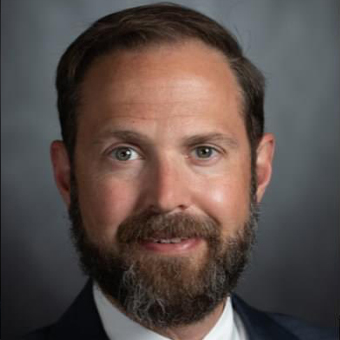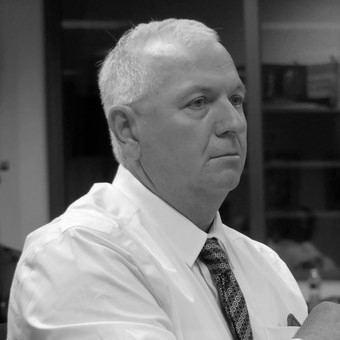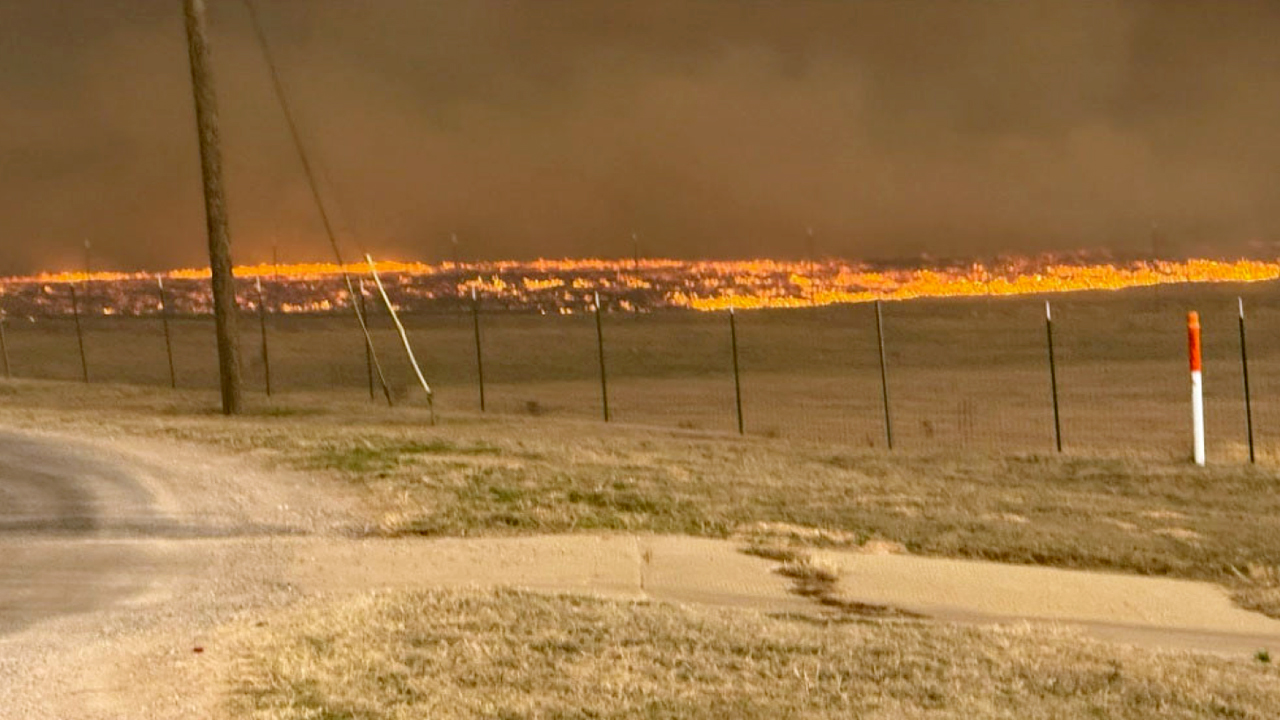Hemphill County, courtesy Investigative Committee on The Panhandle Wildfires
Firefighting planes could have been waiting. They weren’t.
Volunteer firefighters couldn’t refuel their truck to return to battling blazes when their gas card was rejected – a small example of funding issues facing volunteer fire departments.
Coordinating firefighters was a communications disaster – echoing problems seen in the deadly Uvalde school shooting in 2022.
A Texas system for rallying multiple firefighters from around the state was not always effective at putting people in the right place.
Lines from power poles – needing to be replaced – fell, sparking fires. Dilapidated oil and gas equipment contributed to blazes.
All of these and more made it harder to fight the largest wildfire in Texas history – the Smokehouse Creek Fire, which began in late February and was not contained until mid-March.
The massive and deadly blaze along with other wildfires north and east of Amarillo:
- Killed two women.
- Destroyed an estimated 138 homes.
- Killed more than 15,000 head of cattle.
- May have done more than $1 billion of damage to property and lost income, according to state records.
- A report from a legislative investigation looked at the problems and recommended solutions, which we’ve included below.
“The investigation revealed several areas of serious concern, which must be addressed to help prevent and better contain future wildfires,” said Lubbock State Representative Dustin Burrows (R), who served on the committee conducting the investigation.
The aftermath
“It’s huge. It threatens an entire region. It threatens a cattle industry and a beef industry that’s vital to the economy of this state,” Burrows said.

That’s not all. For example, 80 percent of the land in Hemphill and Roberts counties burned.
The report said, “Landowners will be entitled to apply for an exemption from the obligation to pay a portion of their property taxes for 2024. This will result in a substantial reduction in tax revenue for the county.”
Quail hunting, as just one example, may well be wrecked for two or three years. The report noted hunters pay a fee to be on someone’s property. Some landowners get as much as half their yearly income from hunting fees.
Hunters purchase ammunition, fuel, food, hotel rentals, and other items in the local economy.
Of the surviving cattle, finding forage for them to eat will be much tougher. Same for deer and other wildlife.
The unavailable planes
“We needed to have airplanes available to fight the … fires,” Burrows said. “The federal government made the determination that it was not wildfire season in California. Therefore, we did not need to have planes staged and ready to go in the Texas Panhandle,” Burrows said.
“I said that correctly. They determined because there was not a wildfire season in California, they did not need to have planes staged and ready to go in the Texas Panhandle, an absurd and ridiculous reason for not being prepared – an absurd and ridiculous reason for not being prepared,” he added, repeating his point for emphasis.
Volunteer department woes: A declined card and selling funnel cakes
Volunteer firefighters took a fire truck to a gas station to refuel “ … so they could continue to fight the fires and try to save property and life,” Burrows said of the situation where the gas card was declined.
“That was a very eye-opening story. That should not happen,” Burrows said.
It’s part of a bigger problem, according to the report.
“The Texas Rural VFD Assistance Program was enacted in 2002. … The program is grossly underfunded,” the report said.
On average, for the previous three fiscal years, volunteer departments applied for $43.7 million per year. Less than half, $21.7 million, was distributed each year.
The backlog is $172 million.
“As a result, it is not uncommon for departments to wait a decade or longer before receiving grant funds for purchases of equipment,” the report stated.
A “nothing fancy” fire engine costs $800,000, said Tim Smith, West Carlisle Volunteer Fire Department chief. His fellow volunteers borrowed money for their latest fire engine. Lubbock Lights asked how they paid for it.
“We have to cook funnel cakes,” he said.

Every year at the Panhandle South Plains Fair, West Carlisle VFD sets up a booth and sells funnel cakes, raising about $25,000.
Help from Lubbock County has recently improved.
“Lubbock County in the past five years has done more to help the volunteer fire departments than in the previous 25 years,” Smith said. “Right now, my budget from Lubbock County is around $100,000 a year.”
The cost of gear, hoses, nozzles and breathing apparatus is about $40,000 per year.
Not every department gets as much support from its county. Smith serves on the Texas Commission on Fire Protection and is past president of the State Firefighters’ and Fire Marshals’ Association of Texas.
He thinks catching up on the backlog will make a huge difference in Texas.
“Dustin Burrows is a true friend of the fire service,” Smith said, saying he thinks Burrows will also push for better organization by state officials. It’s listed prominently in the investigative report.
What caused these fires
There wasn’t just one fire, and there wasn’t just one cause.
“A decayed power pole broke at ground level,” the investigation found. Electric wires touching the ground started the Smokehouse Creek fire just north of Stinnett on the morning of February 26.
- That same day, a power pole just south of Pampa broke and crashed to the ground, the report said. Wires fell on dry grass igniting the Grape Vine Creek Fire.
- The 2277 Fire started the next day near an oil field operation. The cause was not listed.
- Reamer Creek Fire started when a power pole broke and brought electric lines down to the ground.
“The committee heard testimony from numerous witnesses that irresponsible oil and natural gas operators … are among the most common culprits contributing to wildfires,” the report said.
“Fire seasons are growing longer, and the fires are larger and more destructive,” the report also said.
Burrows said, “It does seem to be increasing.”
Some of that is from more people living in Texas, he believes.
“Most of these fires are man-made,” Burrows added.
In addition to aging utility poles and irresponsible oil and gas operators, the report cited a regulatory “no-man’s land.”
How bad are the power poles and pump jacks?
The report showed pictures of an oil well with spliced electric wires. A wire was coiled up on the ground. The report said many abandoned wells still have power.
One landowner said 85 percent of the fires on his property have been from oil wells.
The power pole at the cause of the Smokehouse Creek Fire was inspected in January, the report said. It was, “given a ‘priority one replacement’ designation,” the report said. The replacement did not come in time.
“Utility poles and the wires they support tend to fail during high winds, causing fires at the worst possible time,” the report said. The same winds that knock over the dilapidated pole then fan the flames to spread a fire faster.
“The Public Utility Regulatory Act does not authorize PUC to inspect distribution voltage and transmission voltage power lines or to require electric utilities to report the results of its inspections,” according to the report.
Currently, if state regulators find dangerous conditions at a pump jack, the maximum enforcement is a fine.
The investigative committee worried homeowner’s insurance will be more expensive to make up for the massive losses, and utility companies might raise rates to pay for both lawsuits and new utility poles.
The committee thinks Texas should prevent rate hikes for utility companies to pass along their fire-related costs to consumers.
One quick sidenote. Smith thinks power companies could shut off the power during drought conditions on windy days. He said they don’t want to be sued for causing fires if a power line goes down.
The report said Xcel will disable automatic restoration of power when a circuit breaker trips and, as a last resort, will cut power altogether when wildfire conditions are dangerous.
Echoes of Uvalde
“One of the things that we heard is the different agencies aren’t able to talk to one another,” Burrows said.
“We heard some of these same problems that led to the response in Uvalde,” Burrows said. For one thing, agencies use different radio frequencies and different technologies. They don’t always work together.
In 2022, a gunman walked into an elementary school in Uvalde to mass murder 19 students and two teachers. He was then shot and killed by U.S. Border Patrol agents.
Residents and lawmakers harshly scolded law enforcement for a response that was too slow and too uncoordinated. Burrows chaired the legislative committee investigating Uvalde.
“So clearly this is a bigger conversation than just one incident. We have multiple agencies that are responding to emergency situations who are unable to communicate with each other when they need to,” Burrows said.
There’s more in the report.
It said, “The committee heard multiple examples of non-local government agencies directing – and sometimes prohibiting – wildfire response efforts by local government officials, VFDs, and local residents.”
Texas created something called TIFMAS or the Texas Intrastate Fire Mutual Aid System. TIFMAS brings in firefighters from all over the state. Sometimes TIFMAS firefighters have more experience with forest fires than grass fires.
“The committee heard that TIFMAS firefighters often arrive with equipment that is unsuitable to wildland firefighting in the region,” the report said.
Smith thinks TIFMAS is a good program but needs some changes. For one thing, TIFMAS does not include most volunteer fire departments.
“There were firefighters from Galveston – from Houston – from San Antonio. Lubbock County never got a call to come help,” Smith said.
Somebody had to drive a fire truck 12 hours or more, Smith said.
“I just don’t understand why fire trucks are passing 35, 40 fire departments on the way to the fire and those fire departments are not helping,” Smith said.
The TIFMAS training is generally Monday through Friday. Volunteer firefighters often have a full-time job so they are effectively excluded from TIFMAS.
Texas also relies on the Texas A&M Forest Service. The report said the forest service “often ineffectively” redirected response efforts. The report criticized the forest service for not knowing local geography, local roads, local equipment and resources and even local firefighting culture.
Planes or no planes
The forest service requested federal firefighting aircraft right about the same time the first fire started. That’s too late.
“Effective aerial response to fighting wildfires requires positioning of assets based upon conditions well before ignition,” the report said.
Quoting an expert witness, the investigation concluded the forest service should have requested aircraft to get staged and ready three days earlier. Maybe more.
Nim Kidd, chief of the Texas Division of Emergency Management, addressed that issue and was quoted by the Texas Tribune from the legislative investigation’s public hearings.
“Did the federal government jump through hoops to catch up? Yes. But there was a delay,” Kidd said.
Kidd also defended the state’s overall response saying, “Every fire has communication gaps. … The firefighters in this area did expert work.”
Nevertheless, Kidd agreed Texas needs its own fleet of fire suppression aircraft. Burrows thinks it would take five planes at a cost of $4 million to $6 million each.
“I think that’s going to be top of mind – the investments in having some airplanes and helicopters owned by the State of Texas so that we don’t find ourselves waiting,” Burrows said.
The committee recommended Texas should have both its own aircraft – four planes and two helicopters – along with contract aircraft.
Smith is not excited about planes, saying, “I think that’s probably a large expense that’s not gonna get used very often.”
Solutions
The report said, “The committee generally believes residents of the Texas Panhandle are asking for less government intervention, not more.”
And yet, it recommended the state government make changes.
Burrows said, “We don’t love growing the size of government, but when it comes to first responders, when it comes to being prepared and handling emergency situations, that is one of the most – if not the most – critical role of government.”
The legislative investigation concluded wildfire responses should be more localized. Communication, including radio equipment, and training should be coordinated with state and local officials.
Texas should try to persuade federal regulators to relieve firetrucks of the requirement to have emission control because it can cause engine failure on older engines if they idle for too long.
The Texas Department of Insurance should require financial responsibility for the owners of oil and gas wells.
The forest service should let the Texas Railroad Commission know when a pump jack causes a wildfire. The forest service should also update and improve its fire danger forecast system.
Controlled burns on state-owned land were found to be too dangerous. Grazing or mowing might be better. The Texas Department of Transportation should reconsider how tall it lets roadside weeds get before mowing them.
The forest service should also have a database of firefighting resources in each county. Texas should provide much better job protection for volunteer firefighters who put their lives at risk and sometimes their employment on the line.
Local plans
Volunteer fire departments north of Lubbock put together a coalition of departments.
“It’s a group of five fire departments. They send two of their most experienced guys on each truck,” Smith said. They go help each other out.
“The idea is to take one fire truck and two people – not leave your station completely empty. Everybody operates under the same command structure,” he said.
Smith wants to do the same thing across Lubbock County where there are 11 volunteer departments. It will take some work and a little help from the South Plains Association of Governments.
Comment, react or share on our Facebook page.


 Facebook
Facebook